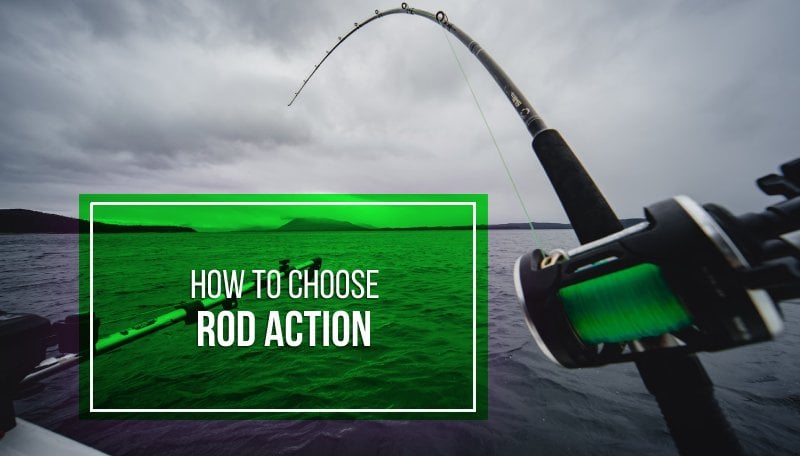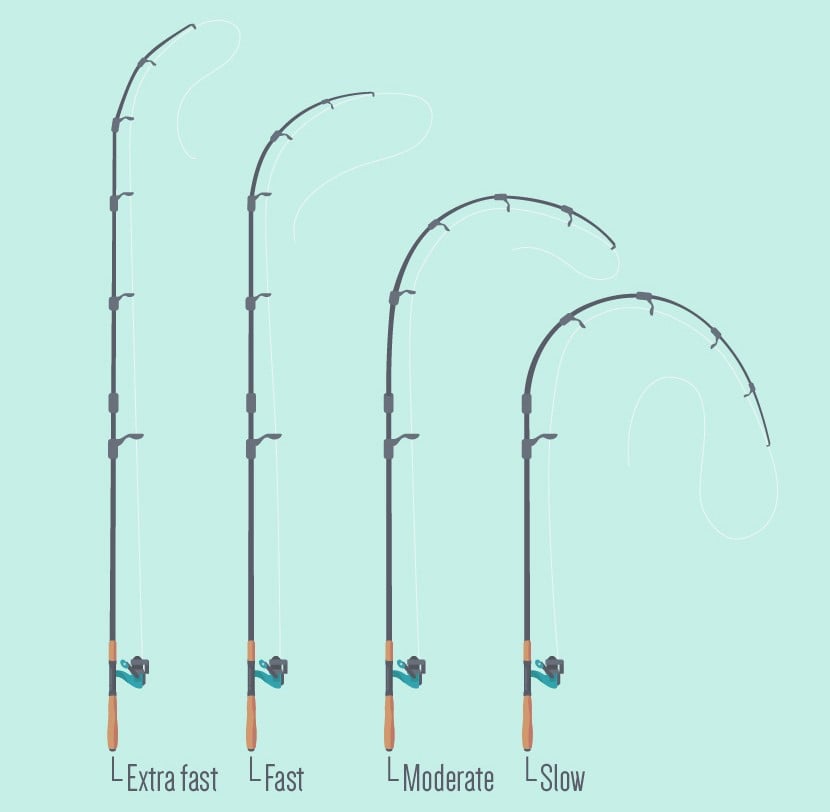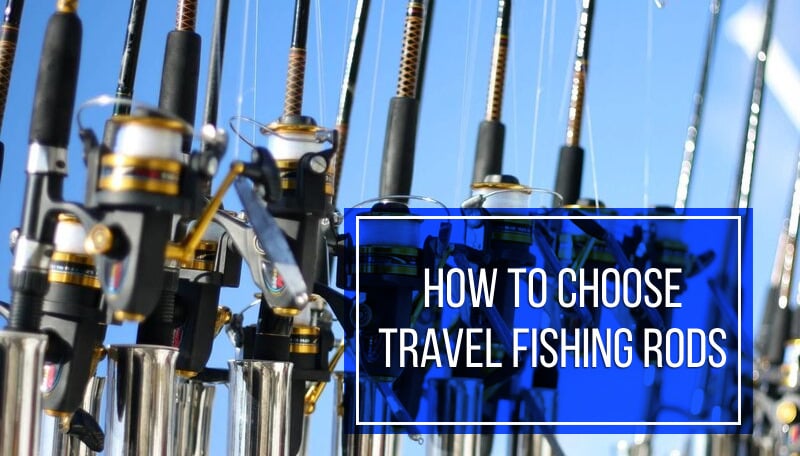Last Updated on
Choosing a fishing rod involves considering three crucial factors: length, power, and action. These factors have a huge impact on your experience and fishing techniques. In this article, we’ll discuss fishing rod’s action – what it is, what the rod action types are, and how they affect casting and fish fighting. Let’s get started!
Table of Contents
Rod Action Explained
Rod Action: Castability, Fish-Fighting Ability, Lures
– Fast Action Rods
– Moderate Action Rods
– Slow Action Rods
Action vs. Power: Understanding the Difference
Final Words
Rod Action Explained
Rod action refers to the point where a fishing rod bends when pressure is applied to it, affecting your casting ability and fish-fighting prowess.
Action can be classified into three main categories: fast, medium, and slow. (There also are two additional in-between ratings – extra-fast and moderate-fast). Let’s take a quick look at how these different actions perform:
- Fast: The rod bends primarily near the tip (20-30% of the rod), making it quick and snappy.
- Moderate: This rod bends further down, closer to the middle (30-40% of the rod).
- Slow: The slow-action rod bends 50% of the rod or deeper.
See the fishing rod action chart below.
Rod Action: Castability, Fish-Fighting Ability, Lures
There are three important things you should understand when considering the rod’s action: castability, its ability to fight fish, and how it works with different lures and fishing techniques.
Fast Action Rods
Fast rods are the most versatile, so if you’re a complete beginner, this is probably what you’re looking for. Because they have a stiffer body, they are very sensitive and quickly load up for hook setting. Fast-action rods allow you to cast accurately at various distances, but only as long as you pair your rod with a proper lure. Generally, to prevent break-offs, you want to pair your fast action rod with a stronger line and tackle.
Castability: Since fast rods don’t bend that much, you’ll not be able to cast a light lure very far. However, their ability to bend primarily near the tip allows them to generate more power and speed needed to cast heavier lures farther downrange.
Fish Fight: One of the most significant advantages of fast-action rods is their sensitivity and quick hook-setting capabilities. The stiffer backbone of these rods ensures that they transmit vibrations along the rod efficiently, allowing you to detect even the subtlest nibbles. Additionally, their rapid hook-setting response gives you an edge when it comes to securing a solid hook-up, increasing your chances of successfully landing a fish. Fast action rods also offer better control during a fight, enabling you to apply more pressure on the fish while maintaining a strong line tension. It helps in tiring the fish out more quickly and reducing the chances of losing your catch.
Lures & Techniques: Fast-action rods excel at handling heavier lures and jigs. Their sensitivity and responsiveness make them perfect for working a jerkbait, topwater lures, twitching, and pitching. However, it’s worth noting that fast action rods might not be the best choice for lighter lures or delicate presentations, as their stiffness can make casting these lures more challenging and reduce their effectiveness.
Moderate Action Rods
Due to being more flexible, moderate rods offer a bit longer cast but still provide enough hook-setting power. Usually, moderate-action rods are the go-to choice when targeting fish with aggressive moving lures. Yep, moderate-action rods are less sensitive, but who needs that when you’re up for reeling in a trophy catch?
Castability: A more parabolic bend allows you to load up and cast a lighter lure farther.
Fish Fight: Moderate action rods strike a balance between sensitivity and power. The progressive bend in the rod serves as cushioning, helping absorb sudden movements and runs from the fish, reducing the risk of broken lines or pulled hooks. It makes moderate action rods particularly useful when targeting hard-fighting species or using lighter lines. A moderate action rod is also better when using treble because it allows keeping fish hooked as it dampens that shock very well.
Lures & Techniques: It works best with crankbaits, spinnerbaits, and other moving lures. Moderate-fast action rods are also great for fishing Walleye with leeches or minnows or Channel catfish with chicken livers.
Slow Action Rods
Ideal for casting lighter lures with a lighter line over longer distances, slow-action rods are perfect for smaller species like panfish. Since the tip returns to the at-rest position slower, slow-action rods are easier to maintain proper tension with, keeping the hook hooked when fighting a fish.
Rod Action vs. Rod Power: Understanding the Difference
When choosing a fishing rod, it’s crucial to consider both action and power. While these terms may seem similar, they refer to different aspects of a rod’s performance. In plain words:
- Rod Action refers to the speed at which a rod returns to its neutral position after being bent. It also indicates where the rod bends along its length, with fast action rods bending near the tip and slow action rods bending throughout the entire length.
- Rod Power is the measure of a rod’s resistance to bending under load. It ranges from ultralight to extra-heavy and determines the rod’s ability to handle different lure weights, line strengths, and fishing situations.
It’s essential to understand that you can’t pick a rod based solely on its action. To choose the right rod power, follow these guidelines:
- Match lures with rod power: Heavier lures require heavier power rods to cast effectively and handle the added weight.
- Pair line strength with rod power: Lighter lines should be paired with lighter power rods to reduce the risk of line breakage, while heavier lines can be used with heavier power rods.
- Consider the fishing environment: Heavier power rods are ideal for fishing dense vegetation and cover, as they provide the necessary backbone to pull fish out of tight spots and prevent snagging.
Final Words
We hope now you have a better understanding of what rod action is and how exactly it influences your cast, fish fight, and the choice of lures and fishing techniques. To provide a couple of examples, a light-power, fast-action spinning rod is an excellent choice for small species like Bluegill, Crappie, and small Trout, as it provides the sensitivity needed to detect subtle bites and handle these delicate fish effectively. Larger fish, such as Black Bass, Walleye, and Channel Catfish, need a medium-power, moderate-fast or fast-action baitcasting rod. Surf fishing often requires a slow-action rod.
FAQ
What is a fast-action rod best for?
Fast-action rods are great for casting heavy lures at long distances as well as fishing smaller fish because it allows you to detect the subtlest nibbles.
What is a moderate-action rod best for?
A moderate-action rod casts lighter lures better and generally works better with moving lures. Ideal for fighting aggressive fish, as it dampens shock better.
What is a slow-action rod best for?
Slow-action rods are best for casting light lures and flies at a long distance.












